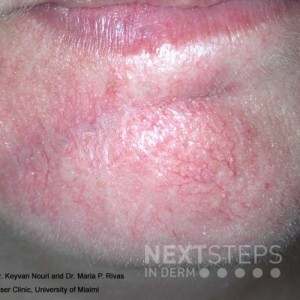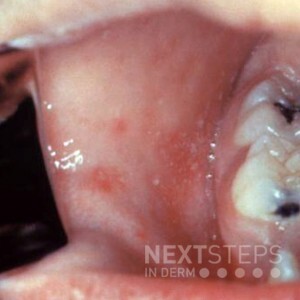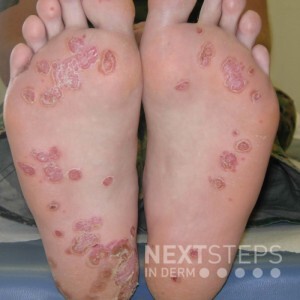Fibrotic Stroma – Friday Pop Quiz 11/26/2021
144371443714437 A 40 year-old female patient presents with the following lesion (see image). The biopsy report shows duct-like structures and tadpole structures within a fibrotic stroma. According to the aforementioned information, the most likely diagnosis is:
A. Microcystic adnexal carcinoma
B. Melanoma
C. Dermatofibrosarcoma protuberans
D. Merkel cell carcinoma
E. Squamous cell carcinoma
To …
A 40 year-old female patient presents with the following lesion (see image). The biopsy report shows duct-like structures and tadpole structures within a fibrotic stroma. According to the aforementioned information, the most likely diagnosis is:
A. Microcystic adnexal carcinoma
B. Melanoma
C. Dermatofibrosarcoma protuberans
D. Merkel cell carcinoma
E. Squamous cell carcinoma
To …
 A 40 year-old female patient presents with the following lesion (see image). The biopsy report shows duct-like structures and tadpole structures within a fibrotic stroma. According to the aforementioned information, the most likely diagnosis is:
A. Microcystic adnexal carcinoma
B. Melanoma
C. Dermatofibrosarcoma protuberans
D. Merkel cell carcinoma
E. Squamous cell carcinoma
To …
A 40 year-old female patient presents with the following lesion (see image). The biopsy report shows duct-like structures and tadpole structures within a fibrotic stroma. According to the aforementioned information, the most likely diagnosis is:
A. Microcystic adnexal carcinoma
B. Melanoma
C. Dermatofibrosarcoma protuberans
D. Merkel cell carcinoma
E. Squamous cell carcinoma
To … Continue reading "Fibrotic Stroma – Friday Pop Quiz 11/26/2021"


 A 4-year-old boy presents to your clinic having recently returned from visiting family in the Philippines. His parents report that he has fever, cough, and nasal congestion. On exam, you notice conjunctival injection and the lesions pictured below. He does not have a rash. What is the most likely diagnosis?
A. Kawasaki disease
B. Rubeola
C. Hand-Foot-Mouth disease
D. Herpangina
…
A 4-year-old boy presents to your clinic having recently returned from visiting family in the Philippines. His parents report that he has fever, cough, and nasal congestion. On exam, you notice conjunctival injection and the lesions pictured below. He does not have a rash. What is the most likely diagnosis?
A. Kawasaki disease
B. Rubeola
C. Hand-Foot-Mouth disease
D. Herpangina
…  This patient presents with an intensely pruritis rash. KOH examination is negative. She denies any recent travel, however does take her 2 year old to the local playground where there is a sandbox. Which of the following is most appropriate?
A. This is likely a dermatophyte despite a negative KOH. Treat with topical antifungals
B. Inform the patient she is contagious and should isolate he …
This patient presents with an intensely pruritis rash. KOH examination is negative. She denies any recent travel, however does take her 2 year old to the local playground where there is a sandbox. Which of the following is most appropriate?
A. This is likely a dermatophyte despite a negative KOH. Treat with topical antifungals
B. Inform the patient she is contagious and should isolate he …  Improve Your Understanding of the Seriousness & Care of Hyperhidrosis with this SWEAT Mnemonic
Severe Sweating - Patients with excessive sweating or hyperhidrosis (Hh) experience severe sweating that is often four or five times more than what’s “normal,” or needed, to regulate body temperature or as a reaction to stress.1 This amount of sweat can be debilitating both physically and …
Improve Your Understanding of the Seriousness & Care of Hyperhidrosis with this SWEAT Mnemonic
Severe Sweating - Patients with excessive sweating or hyperhidrosis (Hh) experience severe sweating that is often four or five times more than what’s “normal,” or needed, to regulate body temperature or as a reaction to stress.1 This amount of sweat can be debilitating both physically and …  In addition to the lesions seen on the feet of this young man he also had geographic tongue, erythematous plaques on his penis and arthritis, what HLA type is associated with this syndrome?
A. HLA-B27
B. HLA-B51
C. HLA-DR1
D. HLA-DR3
E. HLA-DQW2
To find out the correct answer and read the explanation, click here.
Brought to you by our brand partner Derm In-Review. …
In addition to the lesions seen on the feet of this young man he also had geographic tongue, erythematous plaques on his penis and arthritis, what HLA type is associated with this syndrome?
A. HLA-B27
B. HLA-B51
C. HLA-DR1
D. HLA-DR3
E. HLA-DQW2
To find out the correct answer and read the explanation, click here.
Brought to you by our brand partner Derm In-Review. …